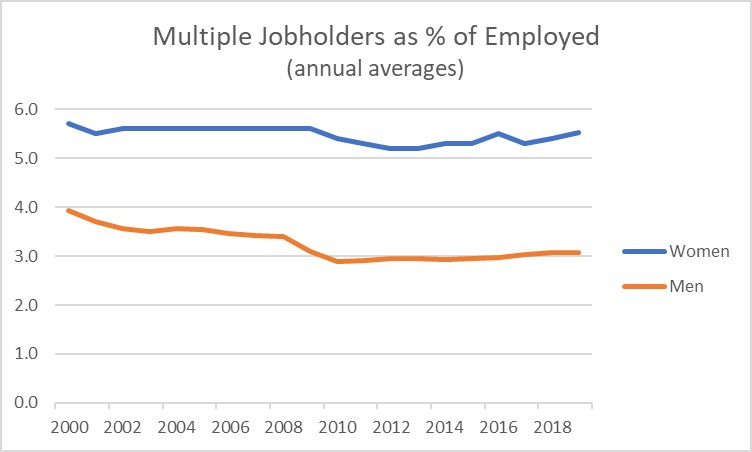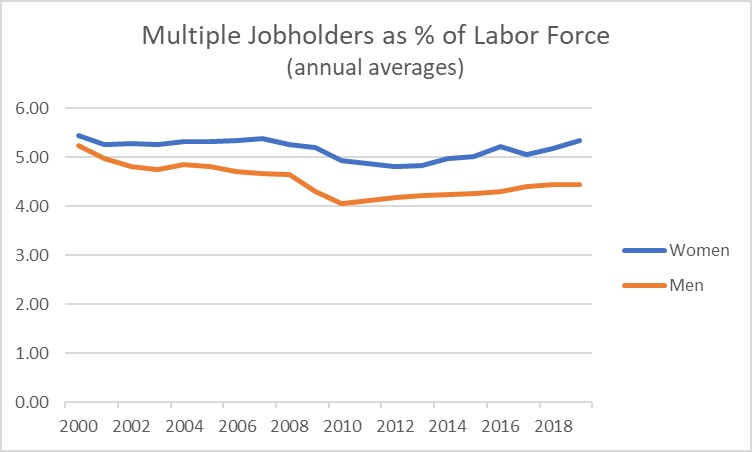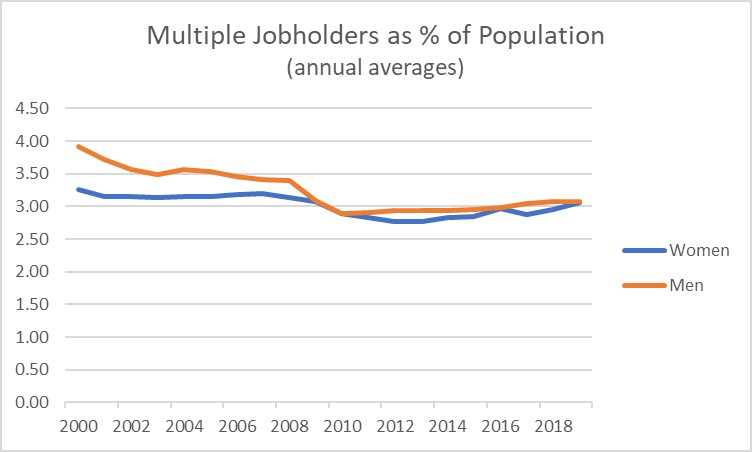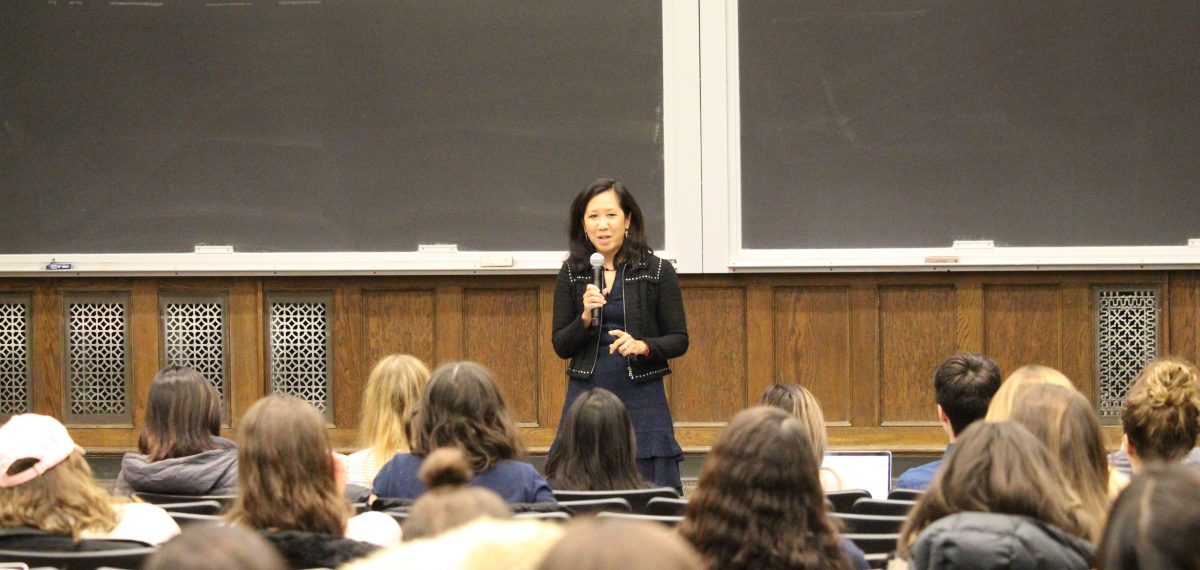The latest Bureau of Labor Statistics employment report (for July 2019), which came out on Friday, was kind of “same old, same old”: service-providing jobs (particularly in healthcare) strong, goods-producing jobs weak, the pace of job growth holding steady, the unemployment rate still really low (3.7%), and wages still rising decently. We’re now in the slowest, steadiest economic expansion on record (since June 2009 according to the NBER), and economists are constantly looking for signs we are finally due for a downturn and pondering if the signs we’re used to looking for aren’t so obvious anymore. With our mix of people who are the foundation of our economy, and the things we people (vs. robots and other countries’ people) do, changing all the time, I often wonder how economists can assume that the patterns the U.S. macroeconomy has followed in the past are well-informing our assessments of where we are headed. How can we predict or even recognize what we haven’t really seen before–something that might be called a “new normal” (clearly, an oxymoron).
One way we know that the economy is different from the last expansion, just from living and looking around us, is the changing nature of work. There are more “gig” or independent workers in the economy now compared with the last expansion, facilitated by the development of mobile online labor platforms that have made it possible for people to supplement their incomes from their main or “real” job with the income from being a Lyft or Uber driver, or a Rover dog walker, or a Thumbtack handyman, or a Grubhub restaurant-food deliverer. Technological advancements alone have likely made this economic recovery’s labor market look different from that of the last one–before such “gigs” ever existed.
So I decided to dig a little deeper into the latest jobs report to see what I could see as any evidence that this was not entirely just a “same old, same old” employment report during a typical (but long) economic expansion. It seemed to me that given the rise of alternative forms of work over the past 10 years, we might expect this to show up in the BLS data on workers who hold multiple jobs. An in-depth analysis of the household data on multiple jobholders was published in the BLS’s Monthly Labor Review in April 2015 on data that ran (only) through 2013. The article by Etienne Lale concluded that:
“Multiple jobholding declined in the United States during the past two decades [1994-2013]. Data from the Current Population Survey show that the trend reflects a lower propensity to moonlight among single jobholders. Multiple jobholders, by contrast, did not become more likely to return to single jobholding…
In 2013, 6.8 million workers in the United States held more than one job. Twenty years before, the figure was 7.5 million, although the total number of workers with a job was lower by 15.9 million. The multiple-jobholding rate— the proportion of multiple jobholders among all employed workers—rose from 6.2 percent in 1994 to a high of 6.8 percent during the summer of 1995. It has declined steadily since then and was at 5.0 percent by the end of 2013. Inspection of data from the Current Population Survey…reveals that the downward trend holds across various sociodemographic groups of the working-age population (those 16 to 64 years old).“
The above analysis had indeed picked up an apparent downward long-term (20-year, 1994-2013) trend in the rate of multiple jobholding among all workers, male and female, and across different age groups and educational attainment levels. The historical time series also revealed the short-term blips up in multiple jobholding that happened during the Great Recession which caused a temporary deviation or at least pause in the downward trend. This reminds us that people who hold multiple jobs often do so because they need the extra income or because one job alone (whether part- or full-time) doesn’t pay enough to pay one’s bills. Was the general downward trend from 1994-2013 due to more people having access to better-paying jobs because of long-term (not just cyclical) improvements in the economy–such that at least in non-recessionary times we should see continued declines in multiple jobholding?
I decided to take a quick spin through the most recent data available (through July 2019), to split the women from the men, and to look at multiple jobholding as a share of some broader populations–not just as % of employed (as BLS calculates for us in their report), but as % of the labor force and as % of overall population. The charts below show (really simple) annual averages of the unadjusted monthly data for all years from 2000 through 2019 (with 2019 showing the average of only the first 7 months in the year, which I can think of reasons why that would bias the number upward as well as downward).



You can see why I titled this post “Women Work A Lot of Jobs”–because the difference between the story for men and the story for women is stark. In the 2015 article cited above, it was already apparent that multiple jobholding was more common for women than for men; since the late 1990s the fraction of employed women working multiple jobs has always exceeded–and increasingly so–the fraction of employed men working multiple jobs. The longer-term downward trend in multiple jobholding that first started in the late 1990s for both women and men appears to have bottomed out after the Great Recession and even started to rise again–a new trend that was hard to spot in the prior analysis that went only through 2013. For women in particular, something about the current economic expansion and whatever the “new normal” might be is causing multiple job holding to be a more common state. As of July 2019, 5.7% of employed women (age 16+) and 5.5% of women in the labor force were multiple jobholders–both the highest monthly shares since 2009 (when the overall unemployment rate hit 10%)! And from the last % of population chart, this says that any woman is now as likely to be a multiple jobholder as any man–regardless of whether they are in the labor market or not! (3.16% of total population for women and 3.25% for men as of July 2019; the chart shows only annual averages.) And that’s multiple jobs in the formal labor market–not even counting all the jobs we do at home before and after “work.”
Why is this happening to women–so differently from men? I can make up several different explanations (below), none of which could be confirmed or rejected without further breakdowns (“crosstabs”) of the data–such as women by age, educational attainment, and marital status–and/or (ideally, and) by conducting survey and focus group research on women vs. men who work multiple jobs and asking them “why?”
- They need multiple jobs to add up to the pay of one job. Women are more likely to earn less than men in even a main, full-time job, holding constant their level of human capital (such as holding a Ph.D. in economics), for all the different reasons that could fill up an entire book: career interruptions having children, having more responsibility in caring for (young or old) family members, being less inclined to ask for raises and promotions, as well as outright (unfair) discrimination.
- They need multiple jobs because their best single job opportunity would still leave them underemployed. Many women reentering the workforce after raising children may find it hard to get hired into a full-time role after so much time out of the labor market. They may also choose to intentionally signal to employers that they need some flexibility in their schedule to attend to their family when needed. This gives the employer an excuse to underpay and underemploy them. (Women who reveal they are not only mothers but also wives receive the double whammy of signaling that they don’t need a full-time job because they have a spouse to support them. Economists know this result from recent research showing the effects of the birth of a child on a father’s vs. a mother’s earnings.)
- They choose to work multiple jobs not because of the money but because of how they want to spend their time and use their talents. I recently got remarried, and it kills me when women say “congratulations, you don’t have to work anymore!” (Men wouldn’t dare say that to me.) I’ve always worked multiple jobs even while having one really good full-time job, because I like doing things other than my main job, and sometimes I even get paid a little for those other things (like teaching economics one evening a week and teaching yoga on Saturday mornings). Did you know that women 55 and over are projected to be the single fastest growing segment of the labor force over the next decade? Many of us have high levels of human capital and have had productive careers thus far, but now that the kids are grown, we have more time and energy and wisdom and can actually work harder in the market economy than ever before–but we can also afford to be choosy about how we work, and often a combination of part-time roles that are customized to our skill sets and talents will be more attractive to us than one full-time, cookie-cutter role (which maybe any old man or younger person could fill).
So the phenomenon of holding more than one job is definitely not a thing of the past. It’s also not a thing that necessarily gets worse/more prevalent during recessionary times, given that its rates as a share of whatever denominator you use–employed, labor force, or total population–are as high now as during the Great Recession. It’s also not easy to blanket-characterize as a bad thing (forced by economic hardship) or a good thing (more opportunities to be productive in more ways). I think it’s a great example of something important happening in our economy which to better understand, we need to do more quantitative and qualitative research on–by analyzing more disaggregated (“granular”) data, and by having conversations with more individual people (those grains in granular!) who I know will have stories to tell, because I do, too.
